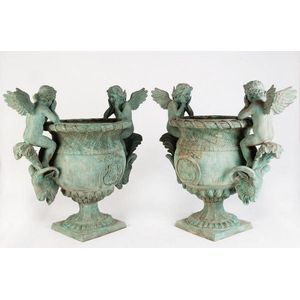Victorian Silver Bread Basket with Swing Handle
You must be a subscriber, and be logged in to view price and dealer details.
Subscribe Now to view actual auction price for this item
When you subscribe, you have the option of setting the currency in which to display prices to $Au, $US, $NZ or Stg.
- Arabesque - The arabesque pattern is an ornamental design that features flowing, curving lines and elaborate geometric shapes. It is inspired by the art and architecture of the Islamic world and was developed at Fontainebleu France in the mid 16th century. Its use was spread through published engravings, and it is characterized by its intricate and highly decorative nature. The arabesque pattern is created using a repetitive motif that is repeated and interwoven to create a cohesive design. It was used as a form of decoration in art, architecture, textiles, pottery, furniture and ceramics and it is often used to add a sense of grandeur and sophistication to a design. The arabesque pattern is admired for its beauty and complexity, and it continues to be used in a wide range of decorative contexts today.
- Victorian Period - The Victorian period of furniture and decorative arts design covers the reign of Queen Victoria from 1837 to 1901. There was not one dominant style of furniture in the Victorian period. Designers used and modified many historical styles such as Gothic, Tudor, Elizabethan, English Rococo, Neoclassical and others, although use of some styles, such as English Rococo and Gothic tended to dominate the furniture manufacture of the period.
The Victorian period was preceded by the Regency and William IV periods, and followed by the Edwardian period, named for Edward VII (1841 ? 1910) who was King of the United Kingdom and the British Dominions and Emperor of India for the brief period from 1901 until his death in 1910. - Engraving - The method of decorating or creating inscriptions on silver and other metal objects by marking the surface with a sharp instrument such as a diamond point or rotating cutting wheel.
- Bread Basket - Bread baskets were commonly used from the 17th to the 19th centuries in Europe and America as a serving piece at formal meals. In the early 17th century, bread baskets were made of wood, pewter and later silver as it was an expensive and prestigious material and demonstrated off the host?s wealth and status.
These bread baskets were usually oval or circular in shape, and were typically decorated with intricate engravings, embossing, and other decorative details. Some were plain and simple, while others were quite ornate, featuring raised scrollwork, beading, or other decorative motifs. Those made in the early 17th century tend to have two handles but surviving examples are rare. From the mid 1770s they usually have a central swing handle. The handles were typically ornate and often curved or scrolled. The shape and size of these baskets varies; some are large, meant to hold multiple loaves, others are more compact and meant for one loaf. By the 18th century, most bread baskets were made of silver. - Foliate - Decorated with leaves or leaf-like forms.
- Angell Family of Silversmiths - There were a number of members of the Angell family who were silversmiths, commencing with Joseph Angell I (also expressed as Joseph Angell, Senior), and his brothers John Angell and Abraham Angell.
On the retirement of Joseph Angell I in 1948, from what had become the leading London silverware workshop, the business was taken over by his son, Joseph Angell II (also expressed as Joseph Angell, Junior), (1815 - 1891).
Joseph Angell II exhibited at the at the 1851 Great Exhibition, the 1853 New York Exhibition, and the 1862 International Exhibition winning medals at each event.
His career is marked by the rich silver items crafted and decorated with chiseling, reliefs and enamels, including trays, tea and coffee sets, jugs, centrepieces and vases
The Victoria and Albert Museum in London holds a number of silver objects by Jospeh Angell II.
This item has been included into following indexes:
Visually similar items

A Victorian sterling silver fruit basket with gadrooned scroll shaped border and raised grape and leaf decoration. Shaped collar base matching swing handle. Hallmarks London, 1859. Maker E & J Barnard. Weight: 602 grams. Width 27 cm

English hallmarked sterling silver Victorian swing handled basket with etched foliate detail & a stag head central cartouche, having a swing handle, with floral edges & a lobed melon-style fluted body, sitting on a pedestal foot. Birmingham, 1844, maker Ro

A pair of large Neo-Classical cast-iron urns. Provenance: Private Collection, Sydney

A Victorian large silver plate table centrepiece on tray, by H.D. Wilkinson of Sheffield, England the mirrored tray with decorative relief border and four protruding scrolling feet, the large baluster stand with conforming base and four removable arms each
